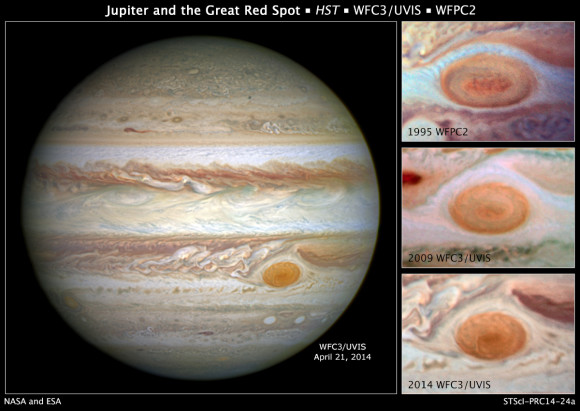
Astronomers have followed the downsizing of planet Jupiter’s Great Red Spot since the 1930s.
“Recent Hubble Space Telescope observations confirm that the Great Red Spot (GRS) is now approximately 10,250 miles across, the smallest diameter we’ve ever measured,” said Amy Simon of NASA’s Goddard Space Flight Center in Greenbelt, Md. Historic observations as far back as the late 1800s gauged the GRS to be as big as 25,500 miles on its long axis. The NASA Voyager 1 and Voyager 2 flybys of Jupiter in 1979 measured the GRS to be 14,500 miles across.
Starting in 2012, amateur observations revealed a noticeable increase in the spot’s shrinkage rate. The GRS’s “waistline” is getting smaller by 580 miles per year. The shape of the GRS has changed from an oval to a circle. The cause behind the shrinking has yet to be explained.
“In our new observations it is apparent that very small eddies are feeding into the storm,” said Simon. “We hypothesized that these may be responsible for the accelerated change by altering the internal dynamics and energy of the Great Red Spot.”
Simon’s team plans to study the motions of the small eddies and also the internal dynamics of the GRS to determine if these eddies can feed or sap momentum entering the upwelling vortex.
In the comparison images one Hubble photo was taken in 1995 when the long axis of the GRS was estimated to be 13,020 miles across. In a 2009 photo, the GRS was measured at 11,130 miles across.
The Hubble Space Telescope is a project of international cooperation between NASA and the European Space Agency. NASA’s Goddard Space Flight Center in Greenbelt, Md., manages the telescope. The Space Telescope Science Institute (STScI) in Baltimore conducts Hubble science operations. STScI is operated for NASA by the Association of Universities for Research in Astronomy, Inc., in Washington, DC.











